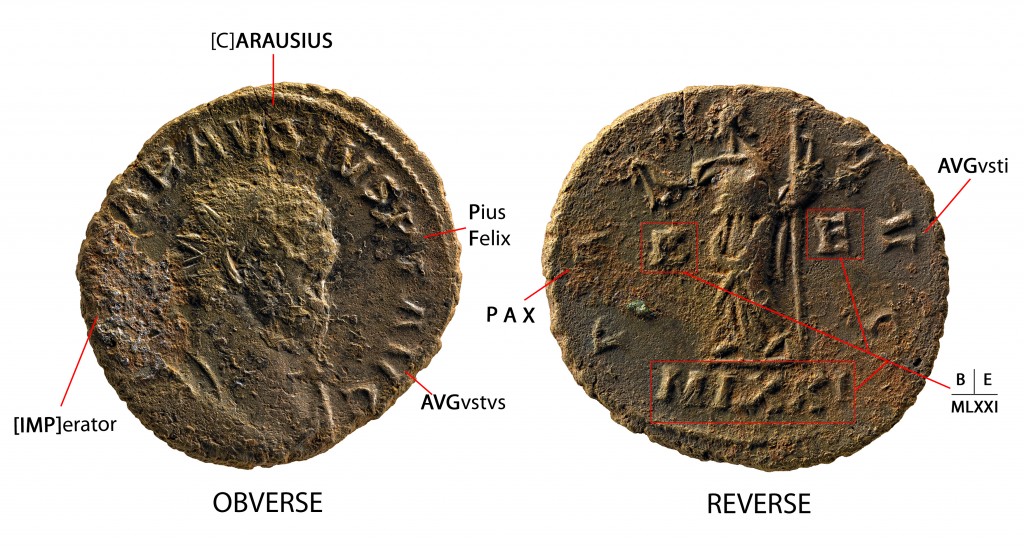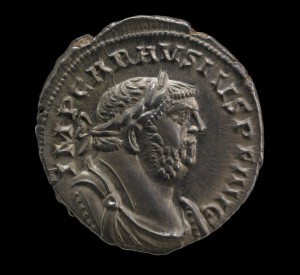The Questions

Dave Crisp at the side of the trench
The quick thinking of metal detectorist David Crisp meant that the Frome hoard was not disturbed upon its initial discovery. This crucial action has allowed for a systematic study of the hoard beginning with its archaeological excavation. As the pot was excavated the ceramic sherds and coins were removed in layers. Each layer was carefully numbered and individually packaged. The British Museum received the hoard in around 60 bags, there being several bags from each layer of the pot. It was hoped that by excavating the hoard in layers it would reveal clues as to why and how the hoard was collected and deposited. These context layers formed a framework for organising the coins and retaining essential deposition information. Having reliable contextual information can help us answer questions like:
- Were all the coins put in the pot at the same time? Because the latest coins, of Carausius, are in the middle of the pot this does seem to be the case.
- Did the coins come from a variety of different individuals or sources? The answer seems to be yes because there are two distinct groups with coins of Carausius in them: a number of earlier Carausian coins were in the last group to be put in the hoard, at the top of the pot, while a large number of later Carausian coins were in a group in the middle of the pot.
- How many different groups (smaller pots, leather bags etc) were emptied into the hoard? We hope that by analysing all the coins, by layer and bag once they have been catalogued, we will gain an insight into how many different groups of coins were in the hoard.
Forward towards some answers
The information stamped onto the coins can help answer these sorts of questions. The LEGEND is the text on a coin which names the emperor (Augustus and Caesar in Latin) ruling at the time of issue. Other titles include commander (imperator), pious (pius) and blessed (felix). Because the Frome hoard was buried towards the end of period in which there were several civil wars and many barbarian invasions, there are around 25 rulers represented over a 40 year period (AD 253 to around 290) The mintmarks on the reverse of the coin often appear in the FIELDS and the EXERGUE of the coin, giving us important information about where and when a coin was struck.
In the illustration of a coin of Carausius (AD 286-93) below, the letters ‘B’ and ‘E’ are mint control letters in the field of the coin – we do not know what they stand for, but there was a large issue of coins bearing ‘B E’. The ‘MLXXI’ in the exergue stands for ‘Moneta Londiniensis’ (the mint of London), one part silver to twenty parts copper (i.e. 5% silver).
The mint marks are often recorded in the format shown at the bottom right of the image.
Carausius reigned from around AD 286 to 293, but we know that this coin was struck in the middle of his reign, around AD 290 and is one of the latest coins in the hoard.
Carausius set up a breakaway empire in Britain and Pax (the personification of peace, as seen on this coin) was the most common reverse type used on his coinage.

A conserved coin of Carausius
After their initial rinse in 2010, the coins were further sorted into bags by emperor, still depending on the layer they were from. Funds were then raised to conserve the approximately 30,000 coins needing further conservation, from the total of 52,503 pieces in the hoard. The relative rarity of Carausius’ coins made them our first conservation priority. The next priority was the illegible coins, pieces with so much corrosion that it was not possible to identify the emperor. These made up roughly 15% of the hoard. Finally, most of the remaining coins were partially identifiable with discernible emperor types but essential information on the reverse remained obscured. Coins in this condition were third in priority for conservation cleaning and have been selected by the curators.
The coin pictured above has been conserved to a legible standard, that is, all textual information has been sufficiently revealed that our numismatist colleagues can identify them. Notice the portrait of Carausius on the obverse still has his eyes and nose covered by corrosion as these areas are not a research priority. The ‘IMP’that precedes ‘CARAVSIVS’ remains hidden by the crystals of corrosion products. In this case, revealing the ‘IMP’ was not necessary as it is commonplace to find it preceding the name of the emperor and there is not much space for much else to fit there. However, there are instances where between the ‘IMP’ and the emperor’s name is a string of other letters that are shorthand for additional titles, such as ‘IMP C CARAVSIVS’ where the additional ‘C’ stands for ‘Caesar’. In other situations one finds ‘IMP C M CARAVSIVS’ where ‘C’ is again ‘Caesar’ and ‘M’ is for his given name ‘Mausaeus’. The presence of these additional letters implies that the coins were struck from different dies, which is important information for our investigations.

Carausius- (286-93): One of the five silver denarii from the Frome hoard after conservation, one of the finest specimens of its kind in existence